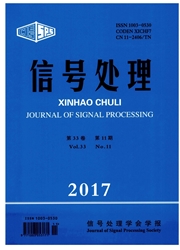

 中文摘要:
中文摘要:
随机极性的连续相位扩展二元相移键控(CP—EBPSK)是一种高频谱效率的调制技术,特殊的冲击滤波器使得门限判决解调成为可能,为了进一步改善其在低信噪比下的误码率性能,引入低密度奇偶校验(LDPC)码作为信道编码。精确的后验概率估计对于译码性能至关重要,但解调方式的特殊性给获取后验概率带来困难。本文引入并分析了贝叶斯方法和支持向量机(SVM)以及两种基于判决门限的后验概率估计法。仿真结果表明,基于SVM和贝叶斯方法较基于判决门限的后验概率估计法更加精确,解调性能可提升8dB-9dB,但在解调之前对需要对码元进行训练,因而复杂度也相对较高;而基于判决门限的后验概率估计法不需要这一过程,因而实现较为简单,性能也可提升7dB以上。所以,在随机极性的CP—EBPSK系统中利用后验概率估计法作为LDPC码译码初始化较为有效。
 英文摘要:
英文摘要:
Random polar continuous phase extended binary phase shift keying (CP-EBPSK) is a modulation technique of high spectrum efficiency. The special impulse response filter makes it possible that using threshold detection to demodulate. To improve the BER performance of the CP-EBPSK demodulator under low SNR, the LDPC code is introduced. Accurate posterior probability estimation is critical for decoding performance, but the special impacting filter used in CP-EBPSK de- modulator brings more difficulty in LDPC decoding after obtaining posterior probability information. Bayesian, support vector machine (SVM) and two decision based posterior probability estimates method are introduced and with detailed analysis in this paper. Simulation results show that, the posterior probability estimation is more accurate obtained by SVM and Bayesian methods than by the two others and the BER performance can be improved 8dB-9dB. Because of the training stage, the complexity of these two methods are relatively high. Decision based posterior probability estimation method which without training is relatively simple and the performance can be improved more than 7dB. Thus, in the random-polar CP-EBPSK system using a posterior probability estimation as the initialization of LDPC decoder is an effective way.
 同期刊论文项目
同期刊论文项目
 同项目期刊论文
同项目期刊论文
 期刊信息
期刊信息
